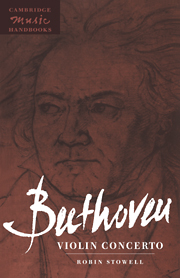Book contents
- Frontmatter
- Contents
- List of figures
- Preface
- 1 Towards the Violin Concerto Op. 61
- 2 The genesis of Op. 61
- 3 Reception and performance history
- 4 The textual history
- 5 Structure and style I – 1. Allegro ma non troppo
- 6 Structure and style II – 2/3. Larghetto – Rondo: Allegro
- 7 Cadenzas
- Appendix 1 Select discography
- Appendix 2 Published cadenzas
- Appendix 3 Textual problems perpetuated in some printed scores
- Notes
- Select bibliography
- Index
6 - Structure and style II – 2/3. Larghetto – Rondo: Allegro
Published online by Cambridge University Press: 28 October 2009
- Frontmatter
- Contents
- List of figures
- Preface
- 1 Towards the Violin Concerto Op. 61
- 2 The genesis of Op. 61
- 3 Reception and performance history
- 4 The textual history
- 5 Structure and style I – 1. Allegro ma non troppo
- 6 Structure and style II – 2/3. Larghetto – Rondo: Allegro
- 7 Cadenzas
- Appendix 1 Select discography
- Appendix 2 Published cadenzas
- Appendix 3 Textual problems perpetuated in some printed scores
- Notes
- Select bibliography
- Index
Summary
Reviews of Beethoven's works roughly contemporaneous with the Violin Concerto, such as the Third Piano Concerto and the ‘Eroica’ Symphony, have in common a concern for unity of structure within movements. As its first movement clearly demonstrates, Beethoven's Violin Concerto also responds to such concerns for integration and coherence, and some commentators have even perceived an inner motivic unity within the piece as a whole. Yehudi Menuhin, for example, connects the last three notes of the first oboe part in 1/4 with the first three notes of the scale melody introduced by clarinets and bassoons at 1/18, the first three notes (first violins) of the Larghetto, and the last three notes of the first phrase of the principal theme of the finale (solo violin, b. 4), claiming that his observation provides ‘just one small clue to three notes which otherwise, deprived of their symbolic value, would be just three notes of the ascending scale’. He also suggests a relationship between the melodic line of bb. 3 and 4 of the Larghetto and the opening theme of the first movement and particularly the soloist's minor-mode re-statement of this melody at 1/301. While the prominent scale/arpeggio characteristics of much of the first movement's material lend themselves to such analysis in connection with, for example, the solo violin part in 2/51, Menuhin is straining credibility in claiming something other than a mere arpeggio relationship between the explosive tutti figure at 1/28 and the soloist's first elaboration of the theme in the Larghetto (b. 11) or the opening theme of the finale.
- Type
- Chapter
- Information
- Beethoven: Violin Concerto , pp. 74 - 89Publisher: Cambridge University PressPrint publication year: 1998



